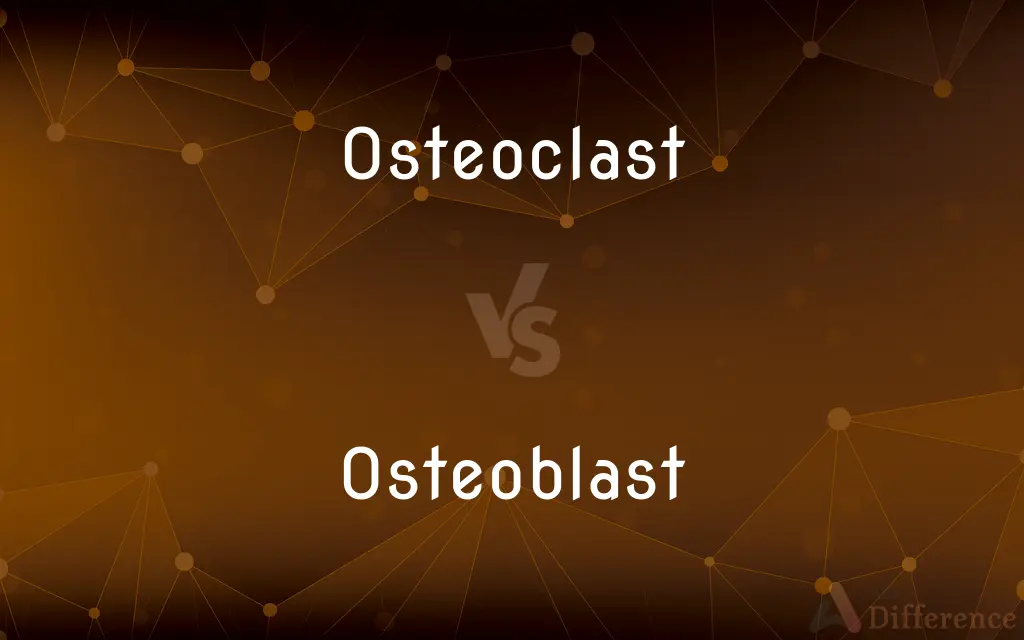Osteoclast vs. Osteoblast — What's the Difference?
By Fiza Rafique & Maham Liaqat — Updated on March 21, 2024
Osteoclasts break down bone tissue, aiding in bone resorption, while osteoblasts are responsible for bone formation and regeneration.

Difference Between Osteoclast and Osteoblast
Table of Contents
ADVERTISEMENT
Key Differences
Osteoclasts are large, multinucleated cells that play a crucial role in bone resorption, which is the process of breaking down bone tissue. These cells help in the maintenance, repair, and remodeling of bones by dissolving bone minerals and collagen matrix. Osteoblasts, on the other hand, are mononucleated cells responsible for bone formation. They synthesize and secrete the collagen matrix and mineral deposits, leading to new bone growth and bone regeneration.
While osteoclasts are derived from monocyte/macrophage precursor cells, which are a type of white cell, osteoblasts originate from mesenchymal stem cells. This difference in origin highlights the diverse nature of these cells in bone physiology. Osteoclasts, with their ability to break down bone, play a role in the release of calcium into the bloodstream, whereas osteoblasts consume calcium to create new bone, thereby lowering calcium levels.
Osteoclast activity is critical in the process of bone remodeling, where old or damaged bone is removed to make way for new bone. This process is essential for the maintenance of strong and healthy bones. Osteoblasts work in coordination with osteoclasts by filling in the spaces created by osteoclasts with new bone. This balanced activity between osteoblasts and osteoclasts is crucial for bone health and structural integrity.
An imbalance between osteoclast and osteoblast activity can lead to various bone diseases. Excessive osteoclast activity can result in conditions like osteoporosis, where bones become weak and brittle. Conversely, insufficient osteoclast activity or overly active osteoblasts can lead to conditions where bones are abnormally dense and prone to fractures.
Osteoclasts and osteoblasts are regulated by a variety of hormonal and molecular signals. For example, parathyroid hormone (PTH) and RANKL (receptor activator of nuclear factor kappa-Β ligand) stimulate osteoclast activity, while calcitonin inhibits it. In contrast, osteoblasts are stimulated by growth factors such as bone morphogenetic proteins (BMPs) and transforming growth factor-beta (TGF-beta), which promote bone formation and regeneration.
ADVERTISEMENT
Comparison Chart
Function
Bone resorption (breaking down bone tissue)
Bone formation (building new bone tissue)
Origin
Monocyte/macrophage precursor cells
Mesenchymal stem cells
Cell Type
Multinucleated
Mononucleated
Role in Bone Health
Removes old/damaged bone, releases calcium
Builds new bone, consumes calcium
Related Diseases
Osteoporosis (from excessive activity)
Osteopetrosis (from insufficient activity)
Compare with Definitions
Osteoclast
A type of bone cell responsible for the resorption of bone tissue.
Osteoclasts play a crucial role in the maintenance and repair of bones by breaking down old or damaged bone material.
Osteoblast
Stem from mesenchymal stem cells.
The transformation of mesenchymal stem cells into osteoblasts is a critical step in bone formation.
Osteoclast
Derived from monocyte/macrophage precursor cells.
The differentiation of osteoclasts from their precursor cells is stimulated by various hormonal signals.
Osteoblast
Produces new bone matrix and initiates mineral deposition.
Osteoblasts secrete collagen to form the bone matrix, which is then mineralized to harden the bone.
Osteoclast
Large, multinucleated cells capable of dissolving bone matrix.
The multinucleated nature of osteoclasts allows them to efficiently resorb bone tissue.
Osteoblast
A bone cell involved in the synthesis and mineralization of bone.
Osteoblasts are essential for bone growth and the healing of bone fractures by forming new bone tissue.
Osteoclast
Regulated by hormonal signals such as parathyroid hormone (PTH) and RANKL.
An increase in PTH levels can enhance osteoclast activity, leading to increased bone resorption.
Osteoblast
Mononucleated cells that synthesize bone matrix and minerals.
Osteoblasts work together to create the dense, structured matrix of bone.
Osteoclast
Breaks down bone tissue, aiding in bone remodeling.
Osteoclast activity is essential for releasing calcium from bones into the bloodstream.
Osteoblast
Influenced by growth factors such as BMPs and TGF-beta.
The presence of BMPs can stimulate the differentiation of stem cells into osteoblasts, promoting bone formation.
Osteoclast
An osteoclast (from Ancient Greek ὀστέον (osteon) 'bone', and κλαστός (clastos) 'broken') is a type of bone cell that breaks down bone tissue. This function is critical in the maintenance, repair, and remodelling of bones of the vertebral skeleton.
Osteoblast
Osteoblasts (from the Greek combining forms for "bone", ὀστέο-, osteo- and βλαστάνω, blastanō "germinate") are cells with a single nucleus that synthesize bone. However, in the process of bone formation, osteoblasts function in groups of connected cells.
Osteoclast
A large multinucleate cell found in growing bone that resorbs bony tissue, as in the formation of canals and cavities.
Osteoblast
A cell from which bone develops; a bone-forming cell.
Osteoclast
An instrument used in surgical osteoclasis.
Osteoblast
A mononucleate cell from which bone develops.
Osteoclast
A large multinuclear cell associated with the resorption of bone.
Osteoblast
One of the protoplasmic cells which occur in the osteogenetic layer of the periosteum, and from or around which the matrix of the bone is developed; an osteoplast.
Osteoclast
(surgery) An instrument for performing osteoclasis.
Osteoblast
A cell from which bone develops
Osteoclast
Same as myeloplax, a large multinucleate cell within the bone, which functions in the absroption and removal of bone tissue.
Osteoclast
An instrument for performing osteoclasis.
Osteoclast
Cell that functions in the breakdown and resorption of bone tissue
Common Curiosities
How do osteoblasts contribute to bone health?
Osteoblasts form new bone tissue, contributing to bone growth and repair.
What cell type are osteoblasts?
Osteoblasts are mononucleated cells involved in bone formation.
What stimulates osteoclast activity?
Hormonal signals such as parathyroid hormone (PTH) and RANKL stimulate osteoclast activity.
What conditions can result from an imbalance between osteoclast and osteoblast activity?
Imbalances can lead to osteoporosis (excessive osteoclast activity) or osteopetrosis (insufficient osteoclast activity).
Which growth factors stimulate osteoblasts?
Bone morphogenetic proteins (BMPs) and transforming growth factor-beta (TGF-beta) stimulate osteoblasts.
From what do osteoclasts originate?
Osteoclasts originate from monocyte/macrophage precursor cells.
How are osteoclasts and osteoblasts related to bone remodeling?
They work together in the bone remodeling process, with osteoclasts removing old bone and osteoblasts forming new bone.
What is the primary function of osteoclasts?
Osteoclasts are responsible for bone resorption, the process of breaking down bone tissue.
What inhibits osteoclast activity?
Calcitonin is a hormone known to inhibit osteoclast activity.
Can excessive osteoblast activity cause health issues?
Yes, excessive osteoblast activity can lead to abnormal bone density and fragility, as seen in osteopetrosis.
Share Your Discovery

Previous Comparison
Walk vs. Pass
Next Comparison
Unqualified vs. DisqualifiedAuthor Spotlight
Written by
Fiza RafiqueFiza Rafique is a skilled content writer at AskDifference.com, where she meticulously refines and enhances written pieces. Drawing from her vast editorial expertise, Fiza ensures clarity, accuracy, and precision in every article. Passionate about language, she continually seeks to elevate the quality of content for readers worldwide.
Co-written by
Maham Liaqat














































